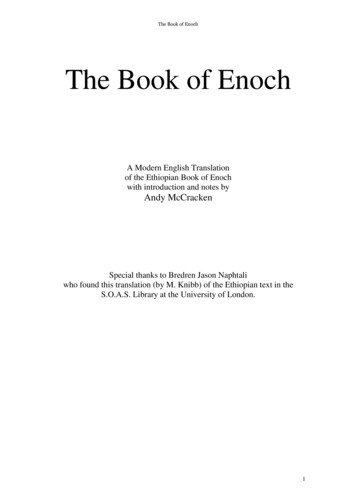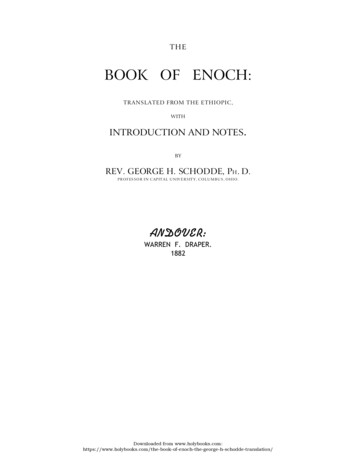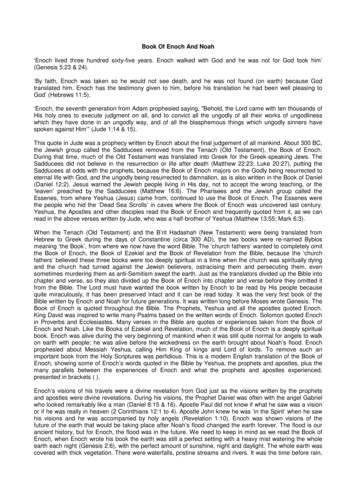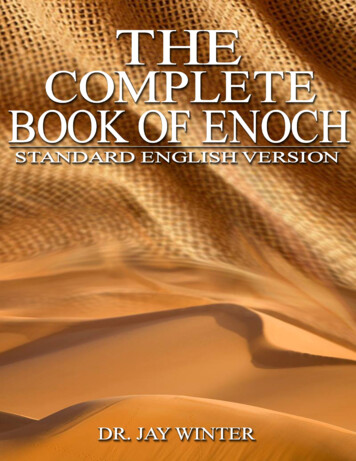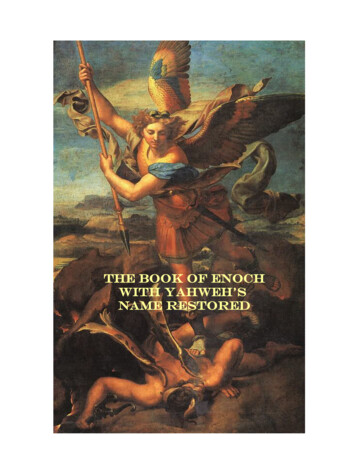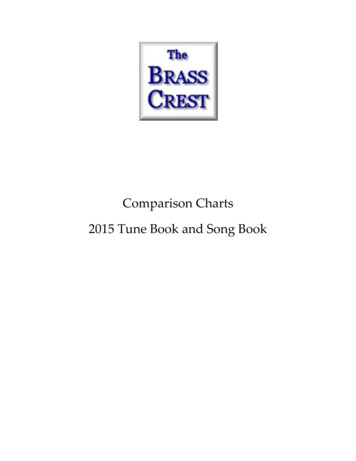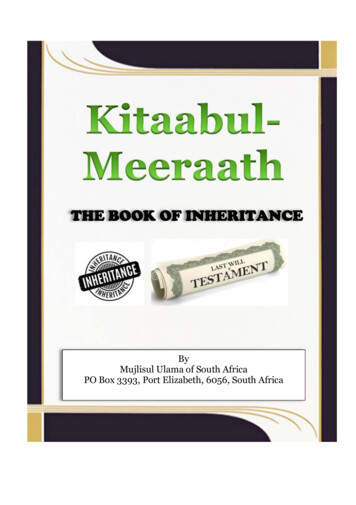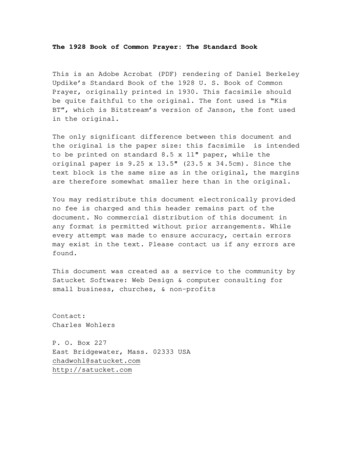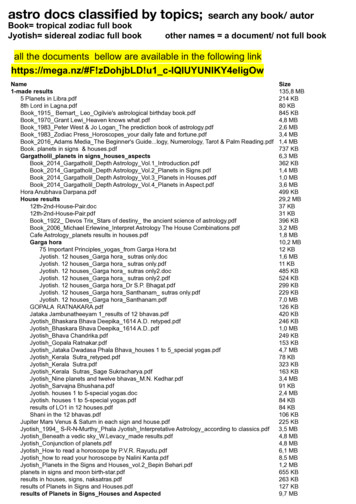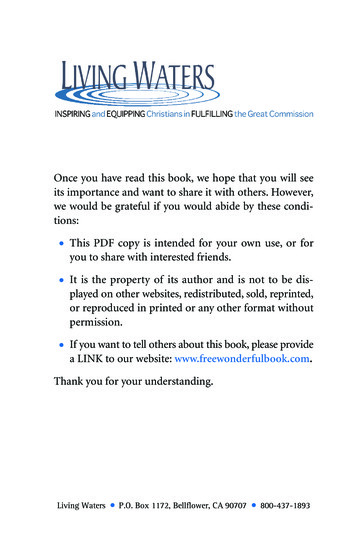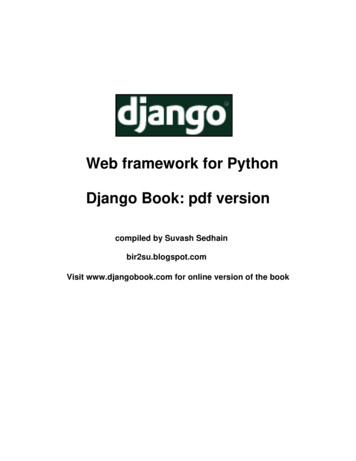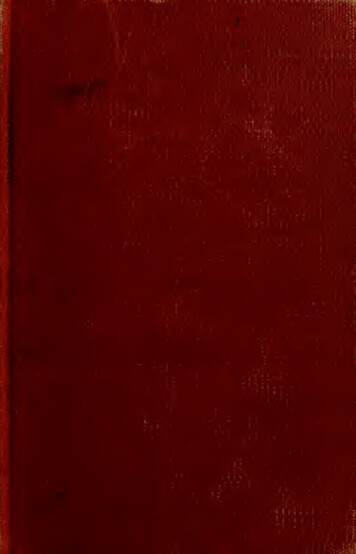
Transcription
' 51830
THE BOOK OF ENOCHTHE PROPHETTKANSLATED FKOMAN ETHIOPICTHE BODLEIAN LIBEARYMS. INBY THE LATEKICHARD LAURENCE,LL.D.ARCHBISHOP OF CASHELTHE TEXT NOW CORRECTED FROMWITHTHE AUTHOR OF:ffWX AVJU1''AN'HIS LATEST NOTESINTRODUCTION BYTHE EVOLUTION OF CHRISTIANITY eVW \W!. WOWV y(5UVA' iU T )/ -puioll i- VVLONDONKEGAN PAUL, TRENCH&CO.,1,1883PATERNOSTER SQUARE
(TTte rightsof translation and of reproduction arereserved.')
INTEODUCTION.In the Authorized Version of the E stle- -Jttde,we read the following words" Enoch also, the seventh from Adam, prophesiedof these, saying, Behold, the Lord cometh with tenthousands of his saints, to execute judgment uponall, and to convince all that are ungodly amongthem of all their ungodly deeds which they have:ungodly committed, and of all their hard speecheswhich ungodly sinners have spoken against Him." Modern research sees in the Epistle of Jude awork of the second centurybut as utterance of an Apostle, let us diligently search theHebrewScriptures for this important forecast of thesecond Advent of the Messiah.In vain we turnover the pages of the sacred CanonApocrypha can we trace onethe marvellous being to whomlinenot even in thefrom the pen of;uninterrupted immor-Compare Book of Enochii.
INTBODUCTION.iyassigned by apostolic interpretation oftality isGenesisv.24.Werethe prophecies of Enoch,therefore, accepted as a Divine revelation on thatmomentous day when Jesus explained the Scriptures, after his resurrection, to Jude and his apostolicbrethren and have we moderns betrayed our trustby excluding an inspired record from the Bible ?;Eeverting to the second century of Christianity,we find Irenseus and Clement of Alexandria citingthe Book of Enoch without questioning its sacredThus, Irenseus, assigning to the Book ofcharacter.Enoch an authenticity analogousliterature,filledaffirmsto that ofthe office of God's messenger to theTertuUian,whoMosaicEnoch, although a man,thatangels.'- flourished at the close of thefirstand at the beginning of the second century, whilstadmitting that the " Scripture of Enoch " is notreceived by some becauseHebrew Canon, speaksit isnot included in theof the author as " themostancient prophet, Enoch," and of the book as thedivinely inspired autograph of that immortal patriarch, preservedby Noahin the ark, or miraculouslyreproduced by him through the inspiration of theHoly Spirit. TertuUian adds, " But as Enoch hasspoken in the same scripture of the Lord, and'every scripture suitable for edification 2Heb. xi. 5."Against Heresies,"iv. 16.Compare Bookisdivinelyof Enocli xv.
INTRODUCTION.vnothing which belongs to us.have been disavowed by theJews like all other scripture which speaks of Christa fact which should cause us no surprise, as theywere not to receive him, even when personallyaddressed by himself." These views Tertullian con-inspired,' let us rejectItmay now seemto—firmsby appealing to the testimony of the ApostleThe Book of Enoch was therefore as sacredJude. Psalms or Isaiah in the eyes of the famouswhom modern orthodoxy relies asthe chief canonist of New Testament scripture.Origen (a.d. 254), in quoting Hebrew literature,assigns to the Book of Enoch the same authorityIn polemical discussion withas to the Psalms.Celsus, he affirms that the work of the antediluvianpatriarch was not accepted in the Churches asDivine and modern theologians have accordinglyassumed that he rejected its inspiration but theextent to which he adopts its language and ideasdiscloses personal conviction that Enoch was one ofas thetheologian, on;:Thus, in his treatise the greatest of the prophets.on the angels, we readthat a special office:"Weare not to supposehas been assigned by mereaccident to a particular angelwork of curing and healing;:as to Kaphael, theto Grabriel, the directionduty of hearing the prayersand supplications of men." From what sourceof wars ";to Michael, theOn FemaleDress,"ii. .«j)q Principiis,"viii.
INTRODUCTION.vibut assumed revelation could Origen obtain andpublish these circumstantial details of ministerialadministration in heaven?Turning to the Book of Enoch we read *' Afterthis I besought the angel of peace, who proceededwith me, to explain all that was concealed. I saidto him, Who are those whom I have seen on thefour sides, and whose words I have heard and:written down.Hereplied.The first is theThe secondthe patient, the holy Michael.merciful,ishe whopresides over every suffering and every affliction ofpresides over all thatispowerful,third, whoGabrieh AndThethe sons of men, the holy Kaphael.iswho presides over repentance and the hopewho will inherit eternal life, is Phanuel." the fourth,of thoseWethus discover the source of Origen's apparentlysuperhuman knowledge, and detect his implicittrust in the Book of Enoch as a Divine revelation.When primitive Christianity had freely appropriated the visions of Enoch as the materials ofconstructive dogmas, this remarkable book graduallysank into oblivion, disappeared out of WesternChristendom, and was eventually forgotten by aChurch, which unconsciously perpetuated its teaching as the miraculous revelations of Christianity.The BookEnoch, unknown to Europeoffornearly a thousand years, except through the frag1BookofEnochxl. 8, 9.
INTRODUCTION.viiments preserved by Georgius Syncellus (circa 792,A.D.), was at length discovered by Bruce in Abyssinia,who brought home three copies of the Ethiopicversion in 1773, respecting which he writesK*:Amongst thearticles Iconsigned to the library atParis was a very beautiful and magnificent copy ofthe Prophecies of Enoch, in large quarto;anotheramongst the Books of Scripture which I broughthome, standing immediately Jbefore the Book ofJob, which is its proper place in the Abyseinianand a third copy I have presented to the, —Cani)n.Bodleian Library at Oxford, by the hands of Br.Douglas, the Bishop of Carlisle."This priceless manuscript, destined, some day, toreveal the forgotten source of many Christian dogmasand mysteries, rested in Bodleian obscurity, untilpresented to the world through an English translation by Dr. Laurence, Archbishop of Cashel,,is;formerly Professor ofHebrewat Oxford,whoissuedhis first edition in 1821, in apparent unconsciousnesshe was giving to mankind the theologicalthrough which we, in the clearer j ightof our generat ion, may study the "Evolution ofthatfossilsChristianity."The scarcity of A rchbishop Laurence'stranslation,before the publication of the second edition in 1833,produced an impression in Germany that the workhad been suppressed byitsauthor;but this report
INTRODUCTION.viiliscontradicted in the preface to the third edition,issued in 1838, in response to a large order fromAmerica.The BookofEnoch excited moreintereston thewas translated intoContinent than in England.ItGerman by Dr. Hoffmanin1838, into Latin byGrfrorer in 1840, again intoGerman by Dillmannin1853, and has been discussed by Weisse, Liicke,Hilgenfeld, and Kalisch, the latter of whom utteredthe prediction, that the book of Enoch "will oneday be employed as a most important witness inthe history of religious dogmas."The day and thehour haye come, the clock has struck, and in thuspublishinganeditiontranslation of theBookofArchbishop Laurence'sof Enoch,we place withinthe reach of all readers of the English language,the means of studying the pre-Christian origin ofChristian mysteries."Turning towards the " Preliminary Dissertationof Archbishop Laurence, in which he discusses, withimpartial criticism and accomplished scholarship,the origin of the Book of Enoch, we find himattaining the important conclusions, that it waswrittenby a Jewof the DispersioninhisownAramaeanacquired in exile that the version in the hands ofthe author of the Epistle of Jude and the AnteNicene Fathers was a Greek translation and thatlanguage, whetherHebrewor the later;;
' Mm INTRODUCTION.theEthiopicwhetheredition,Aramaean or Greek,by the Apostle.translatedfromthe same work as that citedisIn attestation of the theory of an Aramaic orSyro-Chaldsean origin, Archbishop Laurence referstothe"(Hebrewmost ancienttraditions)the Cabbalaremains ofcontained in thespecies of philosophical'Zohar,'acommentary upon the Law,combining theological opinions with the allegoricalsubtleties of theIn this cele-mystical school.brated compilation of what was long supposed toconstitute the hiddenoccasionalwisdomreferencesareof the Jewish nation,madetotheBookofEnoch, as a book carefully preserved from generationto generation."Archbishop Laurence then givesextracts from the "Zohar," referring to importantpassages in theBookof Enoch,andinfersthat"the authors of the Cabbalistical remains wrotetheir recondite doctrines in Chaldee," and possesseda copy of the Book of Enoch, written in thatlanguage or in Hebrew, "which they regarded asthe genuine work of him whose name it bore, andnot as the spurious production of a later age."Archbishop Laurence then considers the probabledate of the work, and infers, from the quotation ofJude, thatitmust have been written antecedenttothe Christian era, but not before the Captivity ofBabylon, becauseitcontainsthelanguage and
INTRODUCTION.Ximagery of Daniel, "in the representation of theAncient of Days coming to judgment with the Sonof man."But since Archbishop Laurence wrote,modern criticism has disclosed how nebulous is thedate of Daniel, so that it becomes as reasonable toassume that the author or compiler borrowed fromthe Book of Enoch, as to attribute plagiarism tothe pseudo-patriarch. The learned translator, however, discovered more satisfactory proof, throughinternal evidence, that the book " was written longsubsequent to the commencement, and evea to theconclusion, of the Babylonian Captivity."That section of the Book of Enoch, extendingfrom chapter Ixxxii. to xc, contains an allegoricalnarrative of the royal dynasties of Israel and Judah,from which Archbishop Laurence constructs ahistory extending from Saul to the beginning ofthe reign of Herod the Great, and infers that theBook of Enoch was written " before the rise ofChristianity most probably at an early period of;the reign of Herod."The Archbishop adds:" That it could not have been the production of awho lived after the inspired authors of theTestament, or who was even coeval with them,must be manifest from the quotation of St. JudewriterNewa quotation which provesit to have been in histime a work ascribed to Enoch himself."Archbishop Laurence, furthermore, attains pro
INTBODUCTION,xibability of date through another line of argument.In chapter"Theliv.9,of thechiefs of the East,Book of Enoch we read,among the Parthians andwhomMedes, shall remove kings, inperturbationshall enter.Theyshalla spirit ofhurlthem'\from their thrones, springing as lions from theirand like famished wolves into the midst ofCommenting on this passage, Archbishop Laurence says, " Now the Parthians werealtogether unknown in history, until the 250th yearbefore Christ, when, under the guidance of Arsacesdens,the flock."name(the familyof all theirsubsequent kings)they revolted from Antiochus Theus, the then kingof Syria.Itwas not, however, until the year 230became firmly established,when Arsaces defeated and took prisoner SeleucusB.C. thattheir empireCallicinus, the Syrian monarch,andKingBythetitleofof Parthia.firstassumeddegrees theyexpelled the Syrian dominion from every provinceover whichitextended east of the Euphrates;sothat from about the year 140 B.C. their vast empirereached from the Ganges to the Euphrates, andfrom the Euphrates to the Caucasus." These factswould therefore lead to the conclusion that theBook of Enoch was written about the middle of theB.C.but as the author adds tothe passage already cited, " They shall go up, andsecond century;tread upon the land of their elect, the land of their
INTBODUCTION.xiielect shall be before them.the path, and the city ofmyThethreshing-floor,righteous people shallimpede the progress of their horses," ArchbishopLaurence connects this language with the invasionof Syria by the Parthians in the year 54 B.C., andtheir defeat of Anthony eighteen years later, " whenthe credit of the Parthian arms was at the highestand it is probable that about the same period, oratnot long after, theleastBookofEnochw aswritten."The question nowwork offictionnaturally arises.Howwas thisaccepted within so short a period, asthe genuine production of the patriarchEnoch ?The Archbishop answersby showing, throughinternal evidence, that the book was written by aJew residing at a distance from Palestine, andhaving been brought into Judsea in the name of theprophet Enoch, the obscurity of its origin causedsome to accept it as the genuine production of thepatriarch himself.In chapter Ixxi. Pseudo-Enochdivides the day and night into eighteen parts, andrepresents the longest day in the year as consistingof twelve out of these eighteen parts.proportion of twelve to eighteensameis''Nowtheprecisely theand twenty, the presentday andnight.If therefore we consider in what latitude acountry must be situated to have a day of sixteenassixteento fourdivision in hours of the period constituting
INTRODUCTION.hours long, we shallxiiiimmediately perceive thatPalestine could not be such a country.We maythen safely conclude that the region in which theauthor lived must have been situated not lowerthan forty-five degrees north latitude, where theis fifteen hours and a half, nor higherlongest dayperhaps than forty-nine degrees, where the longestday is precisely sixteen hours. This will bring thecountry where he wrote, as high up at least as thenorthern districts of the Caspian and Euxine seasit was situated somewhere between theupper parts of both these seas; and if the latterprobablyconjecture be well founded, the author of theofEnoch was perhaps a memberBookof one of the tribeswhich Shalmaneser carried away, and placed *inHalah and in Habor by the river Goshen, and in thecities of the Modes,' and who never returned fromcaptivity."SinceArchbishopLaurencewrotehis" Pre-liminary Dissertation," fresh light has been thrownon the origin of the Book of Enoch through thepublication of Mr. Layard's " Nineveh and Babylon,"recording the discovery, in Babylonian ruins, of cupsor bowls of terra cotta, covered on the inner surfacewith inscriptions in ink, which have been decipheredby Mr. Thomas Ellis of the Manuscript Departmentin the British Museum, as amulets or charms againstevil spirits, disease, calamity, and sudden death,
INTBODUCTION.xivcomposed in tlie Chaldean language mingled withHebrew words/ and written in characters whichcombine Syriac and Palmyrene with the ancientThese inscriptions are undated; butPhoenician.Mr. Ellis attained the conclusion through internalevidence, that these cups belonged to the descendants of the Jews who were carried captive toBabylon and the surrounding cities.But the most important revelation attainedthrough these discoveries of Mr. Layard lies in theinteresting fact, mentioned in his work, that thenames of the angels inscribed on these cups, andthose recorded in the Book of Enoch, are, in manyinstances identical, so that no doubt remains as tothe Hebrew-Chaldee origin of that great Semiticwork, whether assignable to human genius or Divinerevelation;and the exhumed amulets of Jews ofthe Dispersion attest the accuracy of ArchbishopLaurence's conclusions respecting the nationality ofPseudo-Enoch.Ignorance of the contents of the Apocrypha, asis so generalcanonized by the Church of Eome,England that manyinpeople imagine that thefound initsotherwiseBookpages, whereasitofwell-informedEnoch may behas been lost toall" Halleluiah" appears upon the cups; and thus a word, withwhich ancient Syro-Chaldseans conjured, has become, through thevicissitudes of language, the Shibboleth of modern " Kevivalists.
INTR OD UCTION.xrmayEnglish readers, except those whopossess orhave access to copies of the English translationissuedOn1838.inthis aspectlastof the questionArchbishop Laurence writes" The fate of the Apocryphal writings in generalhas been singular. On one side, from the influence:of theological opinion or theological caprice, theyhave been sometimes injudiciously admitted intowhile on the other side,from an over-anxiety to preserve that Canon inthe Canon of Scripture;they have been not simply rejected, butloaded with every epithet of contempt and obloquy.violate,Thefeelings perhaps of both parties have on suchrunoccasionsawayEorwith their judgment.writings of this description, whatevermaymayornot be their claim to inspiration, are at least ofconsiderable utility, where they indicate the theological opinions of the periods at which they werecomposed.This I apprehend to be peculiarly theBookthe case of thebeenmanifestlyofwrittenEnoch;beforewhich, as havingthe doctrines ofChristianity were promulgated to the world,afford us,ofthecrediblewhenitrefers to the natureMessiah, asitmustand characterrepeatedly does so refer,proof of what were the Jewishupon those points before the birthopinionsof Christ;andconsequently before the possible predominance ofthe Christian creed."
INTRODUCTION.xviArchbishop Laurencethusclearlyrecognizedthat the visions of Enoch preceded the teaching ofbut it was not given to him, or to hisJesusgeneration, to see how deeply his conclusions affected;the supernatural claims of Christianity.Turning to the contents of the Book of Enoch,first six chapters announce the conderonation[theIof transgressors and the blessings of the righteous,through the triumphal advent of the Messiah, foreJ3ast in the famous prediction quoted by the authorof the Epistle attributed to Jude.Chapters vii. to xvi. record the descent of twohundred angels on the earth, their selection ofwives, the birth of their gigantic offspring, andthe instruction of mankind in the manufactureand defensive weapons, the fabricationof mirrors, the workmanship of jewellery, and theuse of cosmetics and dyes, combined with lessonsin sorcery, astrology, divination, and astronomyof offensiveallwhich Tertullian accepts as Divine revelation,when he denounces womanas the " devil's gate-and assures her, on the authority of theinspired Enoch, that Tyrian dyes, Phrygian embroidery, Babylonian cloth, golden bracelets, gleambrillianting pearls, flashing onyx-stones, andemeralds, with all the other adjuncts of an elegantway,"- the special gifts of fallen angels totoilette, are "On FemaleDress," bk.i.chap.i.
INTRODTJCTION.lemalajrailtj:.The adventxviiof the angels multiplieson earth, they are condemned to"the lowest depths of the fire in torments," andEnoch, as the messenger of God, announces to themthe eternity of their punishment.Chapters xvii. to xxxvi. give a graphic descriptransgressionstionof the miraculous journeys ofcompanyof an angel, fromEnochwhom hein.thelearns theand the mysteries of Infinity.From the top of a lofty mountain " which reachedto heaven," he beheld the receptacles of light thunder, and lightning, "the great darkness ormountains of gloom which constitute winter, themouths of rivers and of the deep, the stone whichsecrets of creationsupports the corners of the earth, and the four windswhich bear up theof heaven." earth,and constitute thepillarsIs not this obviously the inspired cos-mology, through which the author of the Book ofEnoch unconsciously condemned mediaevalphysiciststo the stake for impiously proclaiming the mobilityIf an inspired prophet saw the stonewhich supports the corners of the earth, how inexpiable the guilt of men, who fostered scepticismthrough the heliocentric theory of a world coursingswiftly round the sunBut had not the Book of Enoch disappeared forof the earth ?!centuries out of Europe, before the persecution of Chap,xviii.C
INTRODUCTION.xviiiGalileo and the martyrdom of BrunothatitsWe?answerteaching had survived, as numerous othersuperstitions have passed from generation to genera-tion long after allbeenknowledge of their origin haslost to the theologianswho accept themasDivine.In the "Evolution of Christianity" we cite thefollowing passage from Ireneeusmorethat the Gospels can beFor:" Itisimpossibleor less than they are.which weand four principal winds, while the Churchis spread abroad throughoutthe earth, and thepillax-and basis of the Church is the gospel andas there are four zones in the worldinhabit,the spirit oflife, it isright that she should hjivefour pillars exhaling immortality on every side,bestowing renewed vitality on men.factitfollows that theWordversions of the Gospel, unitedandFrom whichhas given us fourby onespirit."Wenow recognize that this fanciful theory of a limitednumber of Evangelists is based on the cosmologyof Enochand if in the second century, Irenaeus;accepted the visions of an antediluvian patriarchasfacts,the traditional survival ofthe" corner stone " doubtless controlled theearth'sorthodoxastronomy of mediaeval theologians.Proceeding on his journey with the a,ngel Uriel,Enoch furthermore beheld the prison of the fallenangels, in which struo-o-ling columns of fire ascended
INTRODUCTION.from aBr-ft pfffi&g -arbyss. He saw thew hich th e spirits of the dead await the day of judgment he looked upon the trees of knowledge andof life, exhaling fragrant odours from leaves which;never withered, and from fruit which ever bloomedand he beheld the " great and glorious wonder " ofthe celestial stars, coming forth through the " gatesof heaven."Chapters xxxvii. toIxxi. record thesecond visionTheof wisdom, divided into three j)arables.firstdepicts the future happiness and glory of the elect,whom Enochbeheld reclining on 'couches in thehabitations of angels, or standing in thousands ofthoii sandsand myriads of myriads before the throne Himof God, blessing and glorifyingsong, as the Holy,Holy Lordwith celestialof spirits, beforewhomrighteousness eternally dwells.As Enoch utteredelect,before thehis prophecies respecting theexistence ofChristianity, ijLJbimportant to learn in what sense he understood thedoctrineofelection.The languageoftheparable happily leaves no room for doubtrighteouswillbeelectedtheirforduly weighed by the Lord of Spirits."therefore, traced to its original source,more than Divine " selectiontheory more consistent with the Chap, xxxviii.offirst—" Thegood works Election,means nothingthefittest "—justice of God, than2,
INTRODUCTION.XXthe capricious choice of the metamorphical potter,whose arbitrary fashioning of plastic clay symbolized, inPauline theology, the doctrine of predesti-nation.The second parable (xlv.-lv.) demands the abof modern Jews and Gentilessorbed attentionforitiseitherthe inspiredforecastof a gr eatHebrew prophet, predicting with miraculous accuracythe future teaching of Jesus of Nazareth, or theSemitic romance from which the latter borrowedHis conceptions of the triumphant return of the Sonof man, to occupy a judicial throne in the midstof rejoicing saints and trembling sinners, expectant of everlasting happiness or eternal fire andwhether thesecelestial visionsbe accepted ashumanor Divine, they have exercised so vast an influenceon the destinies of mankind for nearly two thousand"years, that candid and impartial seekers after re ligious truth canno longer delay inquiry intojtherelationship of theBookofEnoch with therevela-tion, or the evolution, of Christianity.Thethird parable (Ivi.-lxx.) recurs, with glowingeloquence, to the inexhaustible theme of Messianicglory,and again depicts the happy future of therighteous in contrast with the appalling misery ofthe wicked.It also records the supernatural controlof the elements, through the action of individualangels presiding over the winds, the sea, hail, frost,
INTRODUCTION.dew, the lightning'sflash,xxiand reverberating thunder.The names of the principal fallen angels are alsogiven, among whom we recognize some of the invisible powers named in the incantations inscribedon the terra cotta cups of Hebrew-Chaldee conjuration.ChaptersIxxi. to Ixxxi. contain the "book of therevolutions of the luminaries of heaven," the sun, themoon, and the stars, controlled in their movementsby the administration of angels. In commentingon this section of the Book of Enoch, ArchbishopLaurence says, "This system of astronomy is pre-\cisely that of an untutored, but accurate observer of/the heavens. He describes the eastern and westernparts of heaven, where the sun and moon rise andset, as divided each into six different gates, throughwhich those orbs of light pass at their respectiveperiods.In the denomination of these gates hebegins with that through which the sun passes atthe winter solstice;andthishe terms the first gate.It of course answers to the sign of Capricornusis;andthe southernmost point to which the sun reaches,both at rising and setting.the sun arrives inrising,itsThe nextgate, atwhichprogress towards the east atand towards the west atsetting,and whichanswers to the sign of Aquarius, he terms the secondgate.Thenexta in continuation of thesame courseof the sun, which answers to the sign of Pisces, he'
INTBODUCTION,xxiiterms the third gate. The fourth gate in his description is that which is situated due east at sunrising, and due west at sun-setting, and which,answering to the signvernal equinox.of WithAries, the sun enters at thethis fourth gatehe com-mences his account of the sun's annual circuit, andof the consequent change in the length of day andnight at the various seasons of the year. His fifthgate is now to be found in the sun's progress north-Andwards, and answers to the sign of Taurus.sixthgateissituatedstillfurther north;hiswhich,answering to the sign of Gemini, concludes at themost northern point of heaven to which the sunarrives,solstice,and from which it turns at the summeragain to measure back its course south-wards." Henceithappens, that the same gates whichanswers to the six signs alluded to in the sun'spassage from the winter to thenecessarilyalsoanswer tosummerthe remainingthe twelve signs of the Zodiac initssolstice,six ofpassage backagain." The turning of the sun both at the wintersummersolstices,last at thethefirstat theandmost southern, themost northern point ofitsprogress,musthave always struck the eye of those who contemplated the variety as well as the splendour ofdaily appearance.The astronomyitsof the apocryphal
INTRODUCTION.xxiiiEnoch was perhaps formed in this respect upon thesame principles as the astronomy of Homer, whoplaces the situation of the island Sup/»j under theturning of the sun, oOi rpoiralXV. 404)."rieXtoio(Odyss.lib.Chapters Ixxxiii. to Ixxxix. contain a vision ofEnocB giving an allegorical forecast of the historyof the worldupChap terxcii.kingdomto therecordsaof the Messiah.of propheciesextend ing from Enoch's own time to about oneseriesthousand years beyond the present generation.Inthe system of chronology adopted, a day stands forhundred, and a weekmadeseven hundred years.forAbraham, the Mosaic dispensation, the building and thedestruction of the Temple of Solomon eventswhich preceded the date at which the Book ofEnoch was probably written but when the author,Referenceisto the-xleluge, the call of—:in his charactei' f a divinely inspired seer, extendshis visionbeyond the horizon ofdiscloses the vanity of hishisownage, hepredictive pretensions,through prophecies which remainunfulfilled.If,however, the Book of Enoch had reached us throughthe Western, as well as the Ethiopic Canon, apologetic theologians would doubtless affirm thatjcen- uries are buttriflesin prophetic time;and thatthe predictions of the great antediluvian prophetshall, sooner or later, attainmiraculous fulfilment.
INTRODUCTION.xxirChaptersto civ. containxciii.the eloquent ex-addressed to his children, inhortations of Enoch,which he follows Buddha in commending the"Paths of Kighteousness," and anticipates Jesusin pronouncing the doom of sinners and the joys ofsaints, and gives utterance to the most emphaticassurance of immortality which hasfrom humanlips":Fearnot,yeever flowedsoulsoftherighteous, but wait with patient hope for the day\of your death in righteousness.IGrieve not becauseyour souls descend in trouble and sorrow to thefor great joy shall be yours,receptacle of the dead;And when youlike that of the angels in heaven.die, sinnersWhatrighteous die.worksprofitBehold, like us,?we die thehave they in theirthey expire in sorrow andsay concerning you, 'AsWhatadvantage have they over us ?Henceforward are we equal; for behold they aredead, and never will they again perceive the light.'in darkness.But now I swear to you, ye righteous . that Icomprehend this mystery; that I have read thetablet of heaven, have seen the writing of the holydiscovered whatand haveones,impressed onitconcerning you.iswritten andI have seen thatand glory have been prepared forThe spirits of you who die in righteousyou.ness shall exist and rejoice and their remembranceshall be before the face of the Mighty One fromall goodness, joy,.;
INTRODUCTION.Howgeneration to generation. xxrprofound the im-pression necessarily produced on the Semitic imagi-nation by this impassioned language, uttered in anage of faith in inspired dreams and celestial visionsby a supposed visitant of the unseen world, who hadconversed with angels in the presence of the Lordof spiritsThechapter of thefinalBookofEnochrecordsthe birth of Noah, and the further prophecies ofEnoch, addressed to Methuselah on the subject ofbirth of Noah and the future deluge.In attestation of the relationship between thetlTerof Enoch and Christianity, we now collate itslanguage and ideas with parallel passages in NewBookTestament scripture.En."Ixiv. 4.Anda voicewas heard from heaven."En.vi."9.Theandiii.And"17.lo,aelectandthe meek, for they shall in-shall possess light, joy,peace,Matfc.voice from heaven, saying."Matt. v. 5. " Blessed arethey shallin-herit the earth."herit the earth."En.select1."Heshallrighteousand2, 4, 5.theholy from atnongthem;forLuke" Your re
thebookofenoch theprophet tkanslatedfkom anethiopicms.inthebodleianlibeary bythelate kichardlaurence,ll.d. arc
